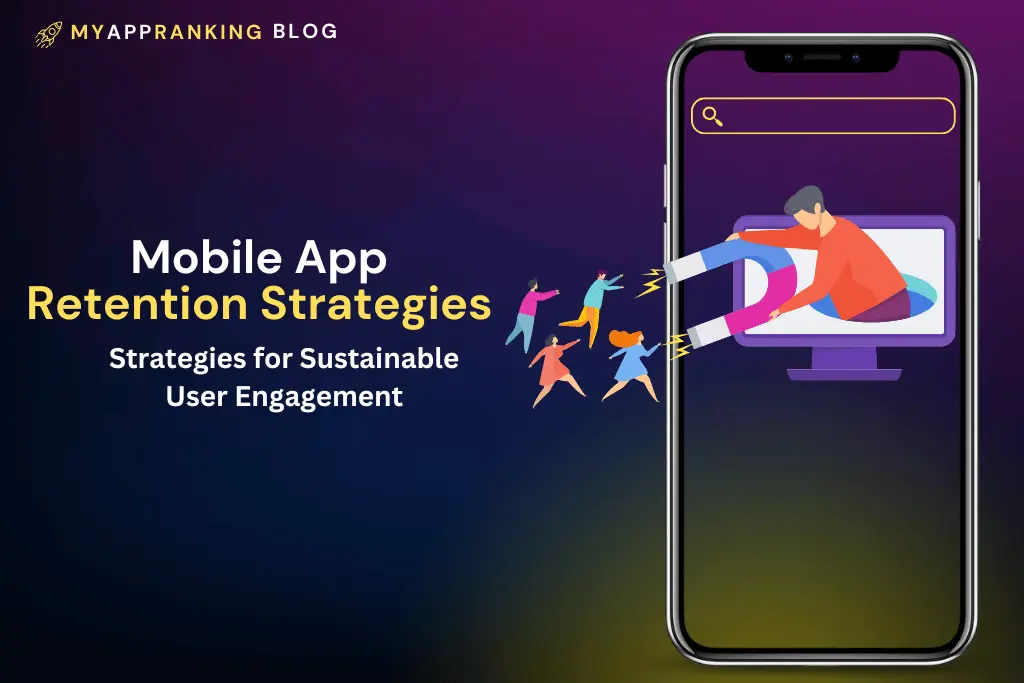A Comprehensive Guide to Mobile App Retention Strategies

In the fiercely competitive landscape of mobile applications, creating an appealing app is just the starting point. The real challenge emerges in retaining users over the long term, making the mobile app retention rate a pivotal metric directly influencing an app’s success. In this comprehensive guide, we’ll delve into various mobile app retention strategies, explore key metrics, and provide insights on how to bolster user engagement for a sustained and thriving user base.
Understanding Mobile App Retention:
1): Mobile App Retention Rate:
The mobile app retention rate is a fundamental metric, quantifying the percentage of users who continue using an app after its initial installation. Typically calculated over specific time intervals, such as one day, seven days, or thirty days post-installation, the retention rate serves as a critical indicator of an app’s stickiness.
2): Mobile App Retention Metrics:
To effectively gauge user retention, app developers and marketers need to analyze various key metrics, including Daily Active Users (DAU), Monthly Active Users (MAU), Stickiness, Session Length, and Churn Rate. These metrics collectively provide insights into user behavior and the overall performance of the app, guiding decisions on improvement and optimization.
3): Mobile App Retention Rate Statistics:
Industry-wide mobile app retention rate statistics offer valuable insights into setting realistic benchmarks. Understanding the average retention rates across different categories provides context for evaluating an app’s performance against broader market trends, helping in refining strategies for better user retention.
Mobile Game User Retention Strategies:
1): Mobile Game User Retention Strategies:
Mobile games face unique challenges in retaining users due to the highly competitive nature of the gaming industry. Successful strategies for mobile game user retention often include regular content updates, in-app events, social integration, and the creation of personalized gaming experiences. These elements not only keep users engaged but also foster a sense of community among players.
How to Increase User Retention:
1): How to Increase User Retention:
Enhancing user retention involves a multifaceted approach. Starting with a seamless onboarding experience, delivering personalized content based on user preferences, incorporating gamification elements to make the app experience enjoyable, and optimizing push notifications to encourage regular use are all crucial elements in increasing user retention.
2): Mobile App User Retention:
Focusing on user-centric design is essential in ensuring a positive user experience. Providing personalized experiences, building a community around the app, and incorporating feedback mechanisms contribute to building a loyal user base. The emphasis should not only be on attracting new users but also on nurturing existing ones for long-term sustainability.
App Retention Metrics and Strategies:
1): App Retention Metrics:
Beyond the basic metrics, specific app retention metrics such as Retention Cohorts, User Lifetime Value (LTV), and App Opens per User offer deeper insights. Retention Cohorts, for instance, allow developers to track the behavior of specific user groups over time, helping in tailoring strategies for different segments.
2): User Retention:
User retention is not merely about retaining users for the sake of numbers; it’s about delivering ongoing value. Analyzing user behavior through detailed analytics, actively seeking and incorporating user feedback, and adapting the app to evolving user preferences are crucial aspects of ensuring sustained user satisfaction.
3): App User Retention:
Building a seamless user experience, offering rewards for loyalty, and employing proactive customer support mechanisms are strategies that contribute significantly to app user retention. Addressing user concerns promptly not only prevents dissatisfaction but also demonstrates a commitment to user satisfaction.
App Retention Benchmarks and Formulas:
1): Mobile App Retention Benchmarks:
Benchmarking an app’s retention against industry standards provides a crucial baseline for evaluation. Different categories, from social media to e-commerce, have distinct benchmarks. Analyzing where an app stands in comparison to these benchmarks guides optimization efforts for improved retention.
App Retention Rate Formula:
The App Retention Rate formula is a fundamental tool for assessing user retention. Calculated by dividing the number of users at the end of a specified period by the total number of users at the beginning and multiplying by 100 to get a percentage, this formula provides a clear measure of an app’s ability to retain its user base over time.
App User Retention Strategies:
1): App User Retention Strategies:
Successful app user retention strategies involve a combination of proactive communication, continuous innovation, and personalized experiences. Leveraging push notifications strategically, implementing loyalty programs, and optimizing the app’s performance contribute to a positive user experience that encourages users to stick around.
Mobile App Engagement Benchmarks and Categories:
1): Mobile App Engagement Benchmarks:
While retention focuses on the sustained use of an app, engagement benchmarks measure the depth of user interaction. Metrics such as Average Revenue Per User (ARPU), screen views, and time spent in the app provide insights into user engagement and satisfaction, guiding strategies for enhancing overall user experience.
2): App Retention by Category:
Tailoring retention strategies based on the specific category of an app ensures relevance and effectiveness. Different app categories experience varied retention challenges; for instance, gaming apps might rely on social features, while utility apps may prioritize seamless functionality. Understanding these nuances helps in crafting targeted strategies for each category.
Conclusion:
In a world inundated with mobile applications, success extends beyond the initial download. Mastering mobile app retention is the key to sustained success. By understanding the intricacies of retention metrics, benchmarking against industry standards, and implementing targeted strategies, developers and marketers can unlock the secrets to long-term user satisfaction and loyalty. The journey doesn’t end with the app installation; it’s just the beginning of a user’s digital experience. Mastering mobile app retention is the cornerstone of building a thriving and engaged user community in the dynamic world of mobile applications.
Do you Want
More App Downloads?
Boost the Mobile App Growth with the Ultimate Mobile App Marketing Experts
Latest Blogs
Do you Want
More App Downloads?
Boost the Mobile App Growth with the Ultimate Mobile App Marketing Experts
Mobile App Retention Rate measures the percentage of users who continue using an app after the initial download, typically calculated over specific time intervals.
Mobile App Retention is crucial for sustained success. It indicates user satisfaction, loyalty, and the app’s ability to keep users engaged over time.
Key metrics include DAU, MAU, Stickiness, Session Length, and Churn Rate. These provide insights into user behavior and guide retention strategies.
Enhance user onboarding, deliver personalized content, incorporate gamification, optimize push notifications, and actively address user feedback.
Yes, mobile games often require unique strategies like regular content updates, in-app events, social integration, and personalized gaming experiences.
Benchmark against industry standards for retention rates, considering specific benchmarks for your app category for a more accurate evaluation.
The formula is [(Users at the end of a period / Users at the beginning) * 100]. It helps calculate the percentage of retained users over a specified time.
Understand the unique challenges of each category. For example, gaming apps might focus on social features, while utility apps prioritize seamless functionality.
Engagement metrics like ARPU, screen views, and time spent are crucial. They measure the depth of user interaction, guiding strategies for a better user experience.
Loyalty programs incentivize users to stick around by offering rewards, creating a sense of value, and fostering a loyal user base.




